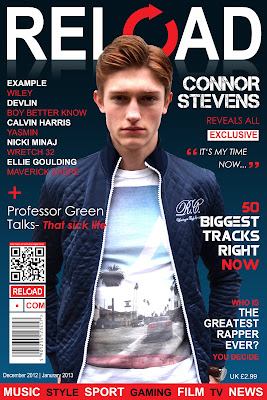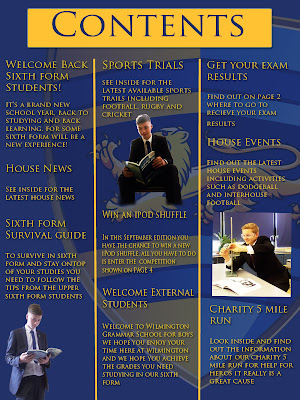Evaluation Question 7
Looking back at your preliminary task (the school magazine task), what do you feel you have learnt in the progression from it to full product?


Since creating my preliminary task I have learnt a massive amount in terms of aesthetic features and media conventions used on magazines. Researching and analysing existing media conventions before I made my music magazine also helped me massively in my progressive learning experience. I have also increased my understanding of technology using resources such as Photoshop, Adobe InDesign, Final Cut, Quicktime, iMovie and equipment like High Definition Cameras, Tripods and Artificial lighting. My knowledge of the media market and magazine industry has also increased a lot due to the research into different media groups and magazine companies.
Whilst creating my magazine and researching into the urban genre I thoroughly looked into the way existing media products portray there genre and one of the main ways they did this was the environment and background of their images throughout the magazine. So when constructing my magazine and taking pictures I ensure the area and environment was urban which relates to my magazine genre. For example for my contents page I have used two examples of brick walls and graffiti which are stereotypically associated with the urban social group.

I also learnt a lot in terms of taking images as the poses and positioning in some of the photos, especially the front cover photo, needs to be striking and dominant. To do this the facial expressions need to be intriguing as if the reader would like to know more about them. Also the body gesture of the male needs to look dominant and powerful as if they look like they are in control. If you look back to the images I took on my preliminary task front cover and contents page they are not as eye catching as my music magazine images. The images below are very boring and not well set up as in I didn't position them into a place where I was able to take an effective front cover photo. Also the background/environment does not portray the genre of the magazine which was a school magazine and I have taken the images on a balcony and beside a tree. Also you can tell that I have learnt a lot in terms of layout, house style and colour coordination which I didn't incorporate into my preliminary task too well as in my music magazine I have used conventions of a unified house style, clear and effective layout and a well colour coordinated design.

I have learnt how to gather feedback to improve my front cover contents page and double page spread in order to develop my work further to look better. Below are the pieces of feedback I got my front cover, contents page and double page spread.
This demonstrates my ability to take constructive criticism and incorporate it into my work to improve it further. I also took the positive comments into consideration to understand and identify what works well together.

 I have also developed my understanding of software programmes massively using Adobe Photoshop and InDesign to help me construct my magazine with more effective tools to make my magazine look more professional and increased my awareness in layout and style. Using software programmes also developed me to create interactivity on my posts. I have learnt to use a variety of different tools creating professional effects in both Photoshop and InDesign which I could now do without having to think about it. I have learnt to also create a CD and Album Cover in Photoshop which I went out of my way to create and show my progression of skills in Photoshop. Another feature I have used to highlight my developed ability in Photoshop is putting my magazine front cover onto a bus stop advertising board which shows my desire to present my ideas on how the magazine would actually be published.
I have also developed my understanding of software programmes massively using Adobe Photoshop and InDesign to help me construct my magazine with more effective tools to make my magazine look more professional and increased my awareness in layout and style. Using software programmes also developed me to create interactivity on my posts. I have learnt to use a variety of different tools creating professional effects in both Photoshop and InDesign which I could now do without having to think about it. I have learnt to also create a CD and Album Cover in Photoshop which I went out of my way to create and show my progression of skills in Photoshop. Another feature I have used to highlight my developed ability in Photoshop is putting my magazine front cover onto a bus stop advertising board which shows my desire to present my ideas on how the magazine would actually be published. 
































